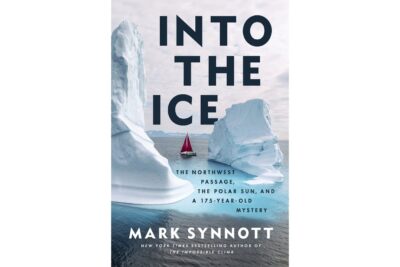Book Review: Mark Synnott heads ‘Into the Ice’ to chase the maritime mystery of Sir John Franklin
By Canadian Press on April 14, 2025.

Mark Synnott admits in the introduction to his new book that “it is out in the high and wild places in this world that I’ve always felt the closest to whoever it is that I really am.” While not exactly poetry, it’s a good summary of the best parts of “Into the Ice,” Synnott’s third work of long-form nonfiction after “The Impossible Climb” and “The Third Pole.” Part travelogue, part historical mystery and part memoir, “Into the Ice” will appeal to fans of extreme adventure stories, nearly all of whom will never sail a boat through the Northwest Passage.
The travelogue moments of the book are the best written, as Synnott and his crew sail his 47-foot boat Polar Sun east to west through the passage, from Nuuk, Greenland, to Nome, Alaska. “When the sun shone directly into the bay, the light reflected off the faces of the ice in infinite shades of blue and green, like a polar disco ball,” Synnott writes on a summer evening in 2022 while conjuring likenesses for icebergs with his young son. (Tommy and Synnott’s wife, Hampton, herself an accomplished sailor, join the crew for a couple weeks at the start of the trip.)
The 6,736-mile journey takes 112 days, which provides plenty of time for readers to learn the story of British Arctic explorer Sir John Franklin and the 128 men he led on an expedition to discover the passage in the mid-19th century. The mystery of what happened to Franklin and all of his men has never been entirely solved, though the wrecks of both his ships were discovered earlier this century. Synnott sets out “in the wake of Erebus and Terror, (to) anchor in the same harbors, see what Franklin and his men saw… Maybe if I fully immersed myself into the Franklin mystery, I might discover what really happened to him and his men.”
Spoiler alert: He doesn’t. You would have heard about it by now. But he does dive deep into the historical record, and that’s where the book loses some momentum. At times it reads like an academic paper, as Synnott references the work of various historians through the years who have investigated the Franklin expedition. He takes us back nearly two centuries to recount Franklin’s career and what is known about his third attempt to map the Northwest Passage from 1845-1847.
The tale is more compelling when Synnott is engaging with living Franklin-ologists like Canadian Tom Gross, who has been searching for Franklin’s tomb and collecting evidence of what happened for decades. Gross was scouting King William Island in a small plane in 2015 when he observed “two black stones standing up vertically on a ridge” that did not belong a few miles inland. But in their excitement at the discovery, he and his co-pilot forgot to note the GPS coordinates and he’s still looking for what he believes were markers of Franklin’s tomb a decade later.
If all this sounds like it might be better watched on TV, you’re in luck. National Geographic funded Synnott’s voyage, as it has many of his previous adventures, and the stunning scenery and drama on the high seas is available to view on Disney+ as “Explorer: Lost in the Arctic.” If you’re not a subscriber, the best parts of the book let readers travel in their mind “beneath massive waterfalls that cascaded from the heights… thousands of feet tall, and where they poured into the sea, clouds of fulmars, cormorants and kittiwakes circled in the salty mist.”
___
AP book reviews: https://apnews.com/hub/book-reviews
Rob Merrill, The Associated Press
-11


